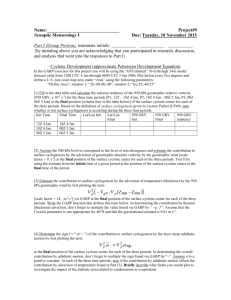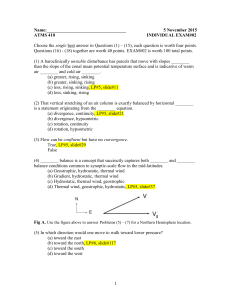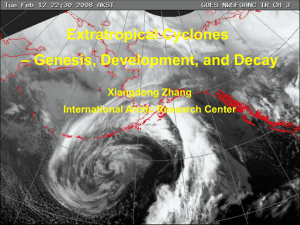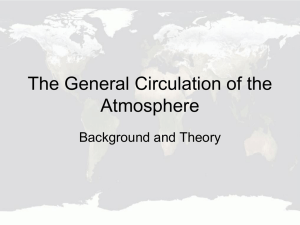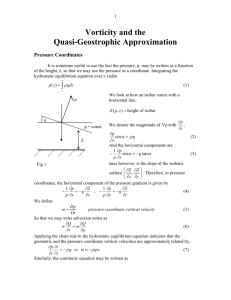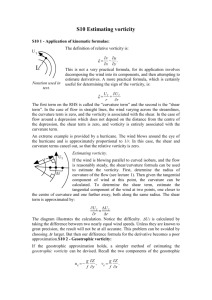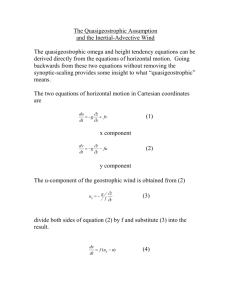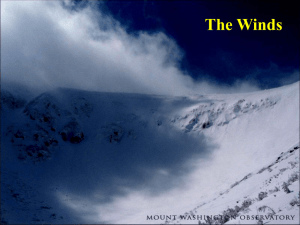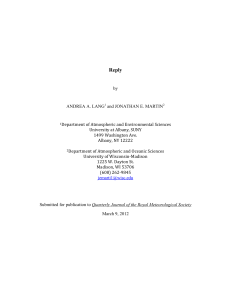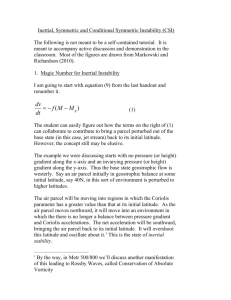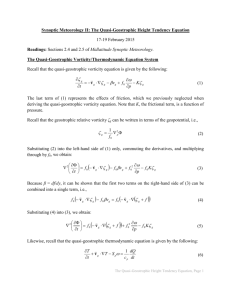Project#8
advertisement
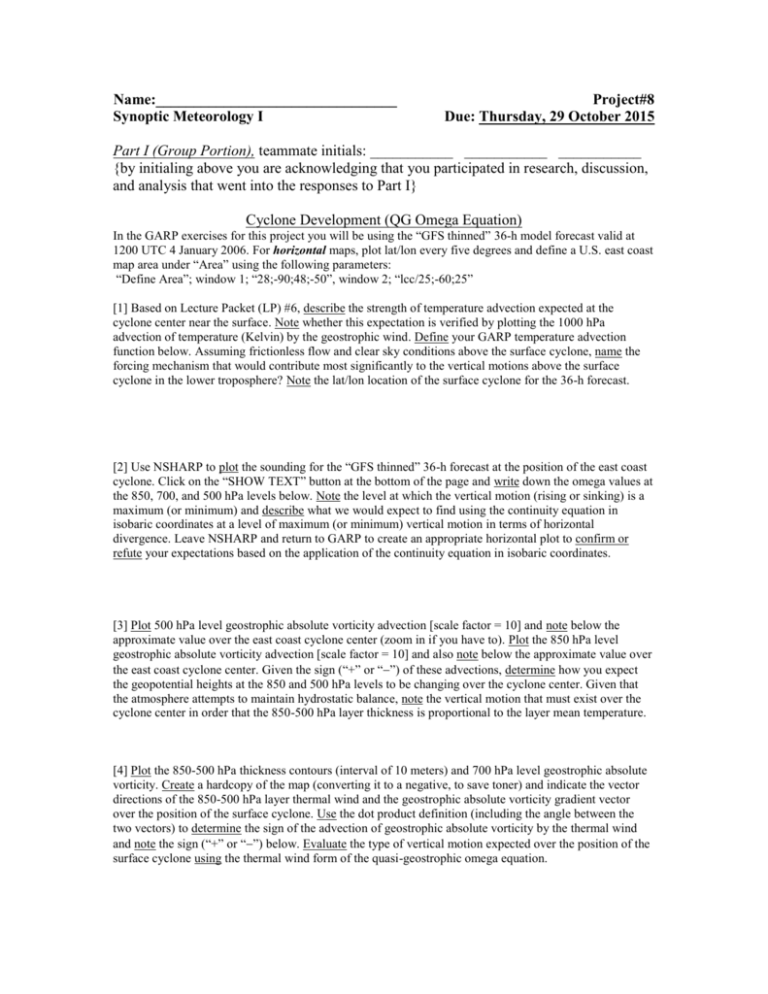
Name:________________________________
Synoptic Meteorology I
Project#8
Due: Thursday, 29 October 2015
Part I (Group Portion), teammate initials: ___________ ___________ ___________
{by initialing above you are acknowledging that you participated in research, discussion,
and analysis that went into the responses to Part I}
Cyclone Development (QG Omega Equation)
In the GARP exercises for this project you will be using the “GFS thinned” 36-h model forecast valid at
1200 UTC 4 January 2006. For horizontal maps, plot lat/lon every five degrees and define a U.S. east coast
map area under “Area” using the following parameters:
“Define Area”; window 1; “28;-90;48;-50”, window 2; “lcc/25;-60;25”
[1] Based on Lecture Packet (LP) #6, describe the strength of temperature advection expected at the
cyclone center near the surface. Note whether this expectation is verified by plotting the 1000 hPa
advection of temperature (Kelvin) by the geostrophic wind. Define your GARP temperature advection
function below. Assuming frictionless flow and clear sky conditions above the surface cyclone, name the
forcing mechanism that would contribute most significantly to the vertical motions above the surface
cyclone in the lower troposphere? Note the lat/lon location of the surface cyclone for the 36-h forecast.
[2] Use NSHARP to plot the sounding for the “GFS thinned” 36-h forecast at the position of the east coast
cyclone. Click on the “SHOW TEXT” button at the bottom of the page and write down the omega values at
the 850, 700, and 500 hPa levels below. Note the level at which the vertical motion (rising or sinking) is a
maximum (or minimum) and describe what we would expect to find using the continuity equation in
isobaric coordinates at a level of maximum (or minimum) vertical motion in terms of horizontal
divergence. Leave NSHARP and return to GARP to create an appropriate horizontal plot to confirm or
refute your expectations based on the application of the continuity equation in isobaric coordinates.
[3] Plot 500 hPa level geostrophic absolute vorticity advection [scale factor = 10] and note below the
approximate value over the east coast cyclone center (zoom in if you have to). Plot the 850 hPa level
geostrophic absolute vorticity advection [scale factor = 10] and also note below the approximate value over
the east coast cyclone center. Given the sign (“+” or “”) of these advections, determine how you expect
the geopotential heights at the 850 and 500 hPa levels to be changing over the cyclone center. Given that
the atmosphere attempts to maintain hydrostatic balance, note the vertical motion that must exist over the
cyclone center in order that the 850-500 hPa layer thickness is proportional to the layer mean temperature.
[4] Plot the 850-500 hPa thickness contours (interval of 10 meters) and 700 hPa level geostrophic absolute
vorticity. Create a hardcopy of the map (converting it to a negative, to save toner) and indicate the vector
directions of the 850-500 hPa layer thermal wind and the geostrophic absolute vorticity gradient vector
over the position of the surface cyclone. Use the dot product definition (including the angle between the
two vectors) to determine the sign of the advection of geostrophic absolute vorticity by the thermal wind
and note the sign (“+” or “”) below. Evaluate the type of vertical motion expected over the position of the
surface cyclone using the thermal wind form of the quasi-geostrophic omega equation.
Name:________________________________
Synoptic Meteorology I
Project#8
Due: Thursday, 29 October 2015
Part II (Individual Portion):
The geostrophic wind vector on the 400 hPa isobaric level is plotted for Station B, located at 40 oN, has a
magnitude of 45 m s-1 and blows out of the southwest. Also plotted are isopleths of geostrophic relative
vorticity that vary only in the East-West direction. The geostrophic relative vorticity isopleth through
Station B has a value equivalent to 25 x 10-5 s-1. The magnitude of the geostrophic absolute vorticity
gradient at Station B on the 400 hPa level is 3.2321 x 10-11 m-1 s-1. The vertical motion observed for Station
B at the 500 and 300 hPa levels is – 4 x 10-3 mb s-1 and –2 x 10-3 mb s-1, respectively. Determine the critical
geostrophic components at Station B ( u gB and
v gB ) on the 400 hPa isobaric level that are necessary to
offset the local horizontal divergence such that the 400 hPa geostrophic relative vorticity at Station B is
increasing. Also, determine the values of the geostrophic relative vorticity isopleths A and C. Apply the
quasi-geostrophic vorticity equation in deriving your answer. Assume that the flow at Station B is such that
the Coriolis parameter is essentially constant and that the flow is frictionless. Assume that the horizontal
distance between geostrophic relative vorticity isopleths A and B and between isopleths B and C is 1000
km. Also assume that the geostrophic relative vorticity varies in a linear fashion as it changes east and west
of Station B.

